So here we have it. The first Star Trek series since Enterprise debuted in 2001. My friend and I in high school had watched the series finale of Star Trek Voyager at a local planetarium showing, and when this premiered we were excited to see the next series.
What we saw was disappointment. Coming off of seven seasons of bonkers-as-hell Janeway, Seven, Paris, Tores, Tuvok, and the rest of the Voyager crew, the franchise suggested we go back and watch a show set before The Original Series. What? Why? We were loving the fights with The Borg, and Voyager made it back to the Alpha Quadrant! Ultimately, I would not come back to watching ENT until almost a decade later, when it hit Netflix and I spent the time to watch it. It did not really capture the spirit of Trek I enjoyed, but it wasn’t a bad entry in the series. I suppose time, and other science fiction media, is the testament to both the media and myself.
Discovery has a lot placed upon it in today’s media ecosystem that makes me weary. The lack of Trek, apart from JJ Abrams’ movies, allowed the series to really fall flat for newer fans used to the movie flavor of Trek, more fast-paced action-oriented Trek rather than the cerebral experience Trek is known for. But what I was especially weary of was Bryan Fuller’s involvement in the show. I know he was a writer for DS9 and VOY, but in today’s social justice powered environment, we’ve seen so many other franchises turn to the well of trying to balance every facet of modern society into a show and collapse horrifically trying to do too much at once. To reiterate, I am not against Trek showcasing what Starfleet is known for, many species, many identities, all living and working together. In the book universe, the Titan series of books captured this very well with Captain Riker’s USS Titan, complemented by a crew that highlighted the diversity of the Federation previous shows did not capture as well. In fact, that was an entire story arc of books highlighting what might happen when a band of races get together to seriously challenge the Federation’s principles. But above all, today’s generation has grown up at a time when the space shuttle program has been retired for years, the space station has been up for over a decade, and our missions to Mars, and beyond, have revealed a lot about space not known to my generation when we were kids. The idea of space curiosity is not really found on people today. We like our science fiction full of action, fights, and intrigue. Westworld. Mr. Robot. But other shows have tried to reinvent past themes, like Stranger Things, and on a larger scale, the latest Star Wars film. So what can Discovery do to reinvigorate Trek and reignite the science fiction space exploration genre?
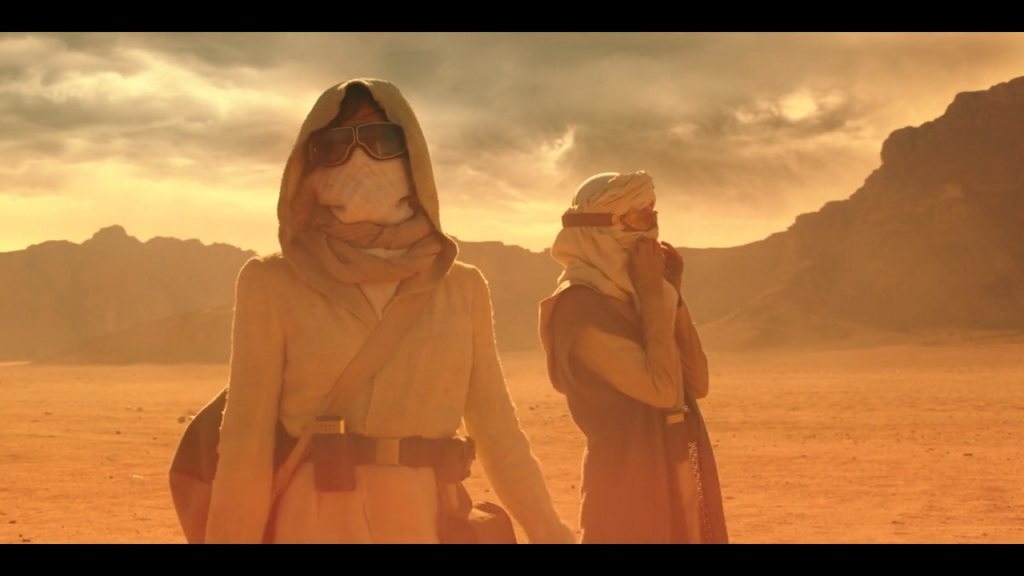
Discovery opens with alien subtitles that quickly morph into English subtitles, and it’s quickly established that these are Klingons, different in appearance compared to Michael Dorn’s iconic Lieutenant Commander Worf from The Next Generation and Deep Space Nine, but also different from how they were portrayed in The Original Series. Their faces resemble much of the same features, but lacking hair and more ceremonial ornaments makes them resemble the Remans from Nemesis, and even the new Klingon leader, T’Kuvma, resembles Shinzon in many ways, right down to the childhood memories. He talks of reunification of the 24 noble houses, or clans, of the Klingon Empire, in order to fight who he perceives is the enemy, humans, Earth, the Federation. The scene shifts to two humans walking through the desert, on an alien planet whose water source is in jeopardy. Citing General Order 1, which is a callback to The Prime Directive, they slip in, resolve the water problem, and spectacularly slip out as the show opening plays.
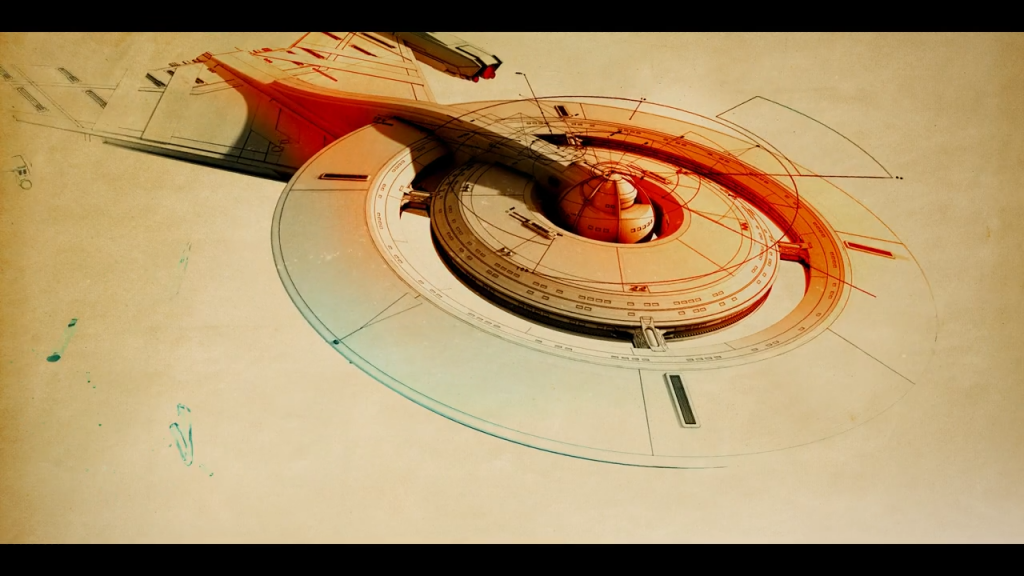
The first thing you notice about the pilot is that the ship isn’t the Discovery, it’s the USS Shenzhou, helmed by Captain Philippa Georgiou, with our lead role, First Officer Michael Burnham, played by Sonequa Martin-Green of The Walking Dead fame. Both are seen in the opening scenes, and become the story for this two-part pilot. This further confuses most people’s perception of Martin-Green being billed as the “first black female lead in Star Trek” considering the franchise has never really had a “lead” character. At most, they have had certain characters billed in the opening credits, often promoting new or more reoccurring characters to title screen status similar to how Saturday Night Live classically divides main cast from featured players. When you realize that “Discovery” does not really start proper until the third episode, it forces the viewer to rely on companion materials rather than the show itself to establish the setting and characters. It’s a very today-television thing, understanding that people have smartphones and tablets with access to IMDB, Wikipedia, and presumably CBS’ own apps to tell them what the show will be about or outline the story synopsis. Past Trek shows did not really have this, so they often had rough first seasons trying to establish their space-feet. Discovery will certainly have that challenge as well, but in today’s high-information and social media world, any doubts can be immediately addressed by the showrunners instantly, so it will certainly affect how the show operates in the future.
Still Lens Flare in Space
Right off the start, we’re treated to what to expect from the exterior and interior design and overall ambience. The standard “Captain’s Log” opening comes out, only by Burnham, as first officer, and the camera pans up to the ship and into the bridge. For current Trek movie fans, almost all of this, including the interior design, is very similar, a lot of flashing screens, ambient sounds, and brightness, too bright really at times. But especially egregious is the use of lens flare.
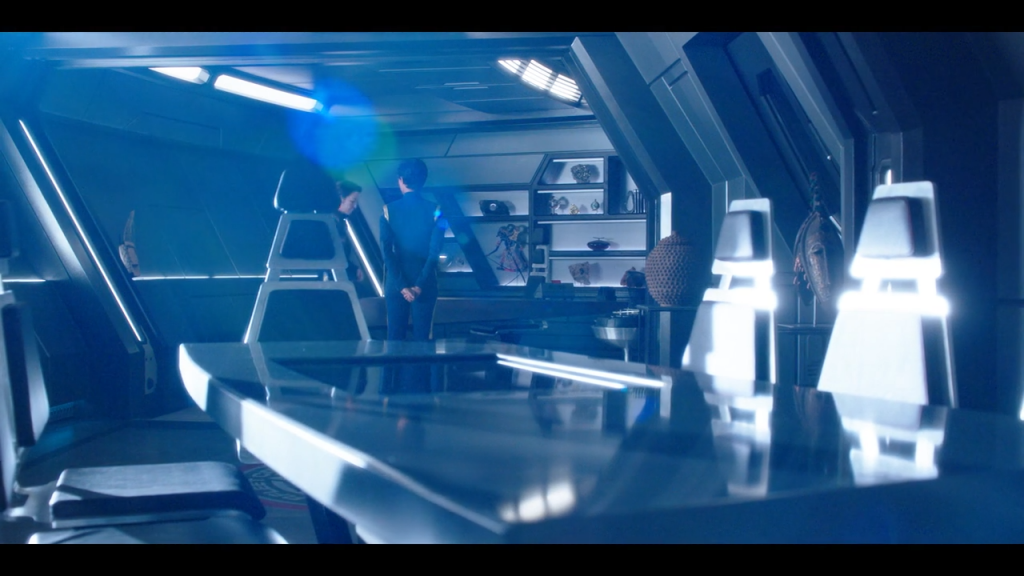
Now you can interpret this, along with much of the way the entire thing is structured, into one major point, and that is that we’re dealing with a show that is being aired on CBS All Access inside the US and Netflix outside of the US. As with today’s on-demand programming, it doesn’t really require the same structure as television, and thus can be done differently, to look and feel more like a movie when played in its entirety. So I can accept that this show will not function the same as old Trek. It’s 2017, not 1997. However lens flare, and just the overall EVERYTHING HAS TO BE BRIGHT thing seems to be more like a callback to the movies intended to pull new movie fans. While important, you’re doing a serialized TV show here, I’d hope your intention is to pull older Trek fans into wanting to support this to not only see it succeed, but launch future projects intended to fully revive this franchise.
But as one friend pointed out, the show’s use of audio effects and ambient noise works very well, and that’s because it uses much of the same sounds and background noise as the original shows, even on the Klingon ship, which looks nothing like the original ships, they too use computer sounds heard on Klingon ships in TNG and DS9. I’m not sure who the computer voice is, but it sounds familiar, and works pretty well. Of course, the technology displayed here seems a bit off considering we’re slightly ahead of Enterprise, but not at The Original Series. I don’t exactly understand why we have subspace holographic communications and all sorts of display screens. I understand we’re updating the show for a modern look, but this is my problem with doing any show set before TOS, it’s conflicts with my understanding of tech canon, and that bothers me.
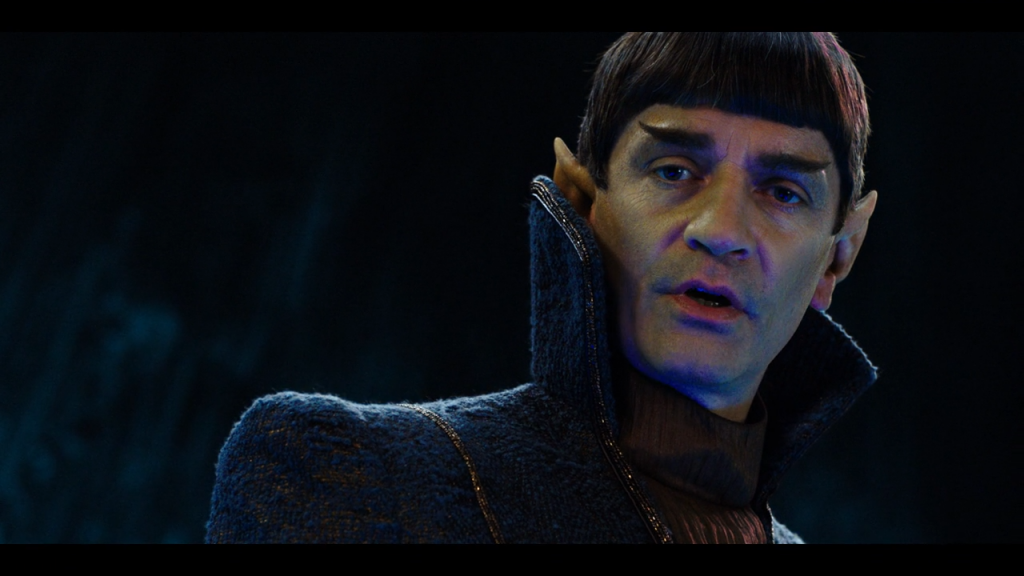
The AMAZING and DIVERSE Cast of Characters
It might sound like I am mocking the byline title, but far from it, I am all for the vision Bryan Fuller has for this series, as long as it isn’t ham-fisted and completely devoid of any soul that makes Trek a good show. Unfortunately, given that only a few characters continue into the rest of the series past the pilot, I clearly was supposed to put all my eggs into the Vulcan-trained T’Pol look-alike Michael Burnham. While I had no real issue with her (is it supposed to be her? I’m not sure if the character name was supposed to mean something more here, no troll) I felt like lacking the seven-year gap of understanding how she went from disciplined graduate of Vulcan to a much more loose-canon character robbed me of really understand why she actually cared so much about Captain Georgiou. I assume this will maybe be explained later on in the show, as it was briefly shown in the middle of the pilot, but unlike previous shows, Discovery asks us to trust in Burnham to carry this show, and I don’t know if I quite agree that in the context of Trek.
As for other characters, we see their faces, but really don’t get introduced to anyone besides Science Officer Saru, who informs us of how his species were effectively some other species’ food supply, akin to livestock on Earth. He advised they turn and leave immediately. Sadly, no one seemed to heed that advice. Several other characters were seen, but either got red shirted, or were not really named. There was some robot-head girl though. Presumably, she’ll be our Data character, if she gets any lines.

Rather, it seems I have to wait to assess one Captain Gabriel Lorca, Discovery’s captain, and played by The OA’s Jason Isaacs, who I hope will provide a reasonable foil for our main character since she is evidently prone to Janeway-ism.
Oh right, I forgot, the Klingons.

Tom Paris Two: Electric Bugaloo
Warning: Spoilers. There will be no further audio warnings.
So this season is being laid out as the Klingon-Federation war, the war between the newly-reformed Klingon Empire and the Federation. I’d have to go look up the backstory from previous lore, but it was a short war that ended in effectively a truce and creation of The Neutral Zone. Honestly, I really would have rather this show opened up on space exploration, even if only to segway into a war in later seasons. But this sounds more like a marketing move above anything else, to draw people into watching the show especially on CBS All Access. The Klingons, for their part, pretty much come off as the current-day ISIS or Voyager-era Kazon, plenty of infighting, plenty of distrust, so really nothing new for Klingons. They were sure to feature one high council member who was female, who I imagine will most certainly be highlighted throughout the season. I’ve read the goal for this show is to run single-season stories, as opposed to single-episode stories or multi-episode arcs like DS9 played with. So the Klingon-Federation War is set to only last this season, which is fine, but leading off with a war is very atypical of Star Trek.
But even more interesting is the choice of running a pilot that establishes a different ship, and different crew, as a means of establishing one character’s story. At the end of the pilot, Burnham is stripped of her rank, and sent to prison. The montage of scenes from the coming episodes seems to imply that she is freed from prison by Discovery Captain Gabriel Lorca similar to Captain Kathryn Janeway’s freeing Tom Paris from prison to take along her first mission into The Badlands, hoping he’d provide information on The Maquis, his former shipmates. But she also saw something in him, as the son of an admiral and ace helmsman. But Tom Paris (Robert Duncan McNeill) was not billed as the lead character of the show, though his character was the focal point of many adventures on Voyager, culminating in his relationship with B’Elenna Torres. It would seem the showrunners are looking to replicate a similar experience here, but in this case they want Sonequa Martin-Green’s character to feature more prominently. Some of that reason surely is to highlight her race and gender, but I think it’s likely more indicative of how showcasting is done today, as many other shows like to develop stories around one or two core characters, especially to fit a more serialized format versus the syndication format that allowed for more open-area storytelling with pools of characters.
So what should we expect from our lead character? Is this Orange is the New Black in space? Will she achieve redemption by the end of the season and be reinstated as First Officer? Will she be the butt of all Klingon jokes from here until the end of time? It’s hard to say. Presumably, there is going to be an impetus on her to form relationships with Discovery crew who either trust her, or are sympathetic to her plight, but she is also likely going to be used as a lighting rod to highlight the ugliness in people during wartime, blaming her for starting the fire, unwanted harassment, and other topical events pulled out of today’s headlines. The Klingons also will be used as a vehicle to likely highlight the ugliness of indoctrination, religious dogma.
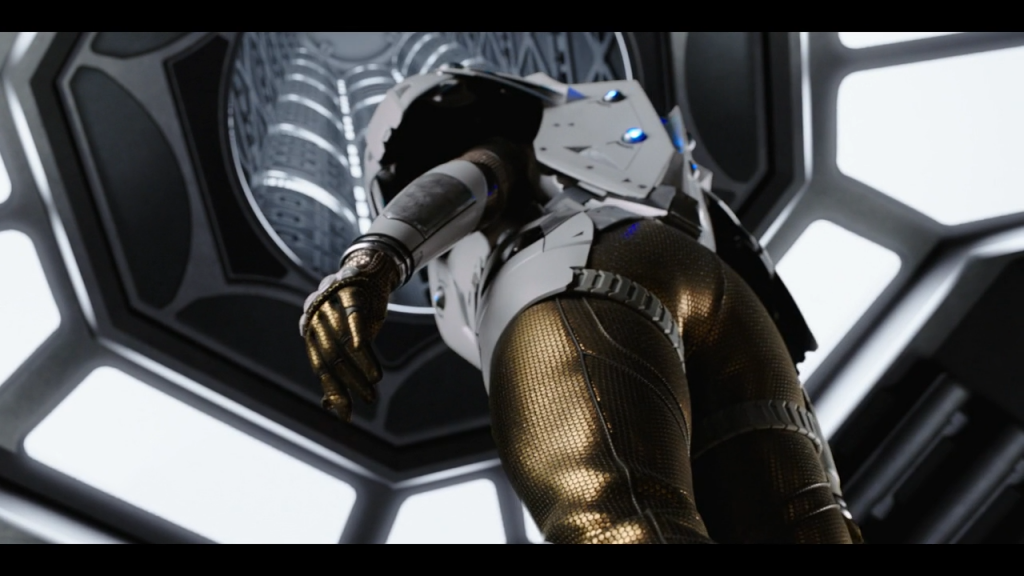
Conclusion
Discovery’s pilot is a strong opening, credit where credit is due, I was sufficiently interested in what was happening to want to keep watching. However I was not particularly invested in any one person yet, besides Burnham. As pilots go, they really serve to establish the universe, the ship, and the characters you’ll be watching. This served more to establish the season’s conflict, but makes you wait another week to really see what you’ll actually be watching all week, which I did not really appreciate. I’m interested enough to continue, because I want to see if they’re going to fall back to a more TV-like pacing, or if they intend to maintain the look-and-feel of the pilot. I am also interested in Rainn Wilson coming in as Harry Mudd though. But as for CBS All-Access, sorry, I don’t like this idea of buying into a bunch of separate online apps for one show a year. HBO is bad enough with Game of Thrones, but I have to draw the line somewhere, especially when Netflix is carrying the show outside of the US. I will really be upset if CBS holds the franchise hostage when they realize there are more Netflix subs watching that All-Access subs. They should deeply consider just dumping the show to Netflix globally next season and nix the All-Access plan, it would do far better for them both viewership and budget-wise as I imagine they could increase how much Netflix is paying for it to offset operational budgets.
The Good
- Sonequa Martin-Green was worth the wait from her AMC contract with The Walking Dead. To play a Vulcan-raised Human, she nails the part fairly flawlessly. Rather, I am worried more about what corner they’re going to try to paint her into writing-wise. They billed her as the FIRST AFRICAN-AMERICAN SERIES LEAD ROLE FIRST OFFIC– wait, convict. Yeah, she may have started off the series as Number One, but then she is busted down to cadet and picked up by a male starship captain. Not sure what message you’re sending there.
- Technobabble
- Plenty of homages and callbacks to the previous shows can be seen, including items in the Captain’s quarters, a dedication plaque on the bridge, computer sounds, engine sounds, uniforms, and more. If anything really works in this show, it’s set design and attention to details.
is still cool, though spare in the opening pilot, but still enough to placate the heart of the Trekkie. Unlike Wars, Trek deals with the deep-tech behind it all. Seven-year-ago Burnham even makes a quip about the ship’s transporter technology not being up to standards, a nod towards the early development of Starfleet technology versus advanced Vulcan technology.
-
The Bad
- The tone and message of the show is going to be closely watched by many because it’s highly-topical right now in the geek/nerd spaces. How many “journalists” couldn’t resist the urge to start controversies over the new Star Wars film and the character of Rey before the next two movies were even out to continue fleshing out her character? I’m sure there are already some hack jobs out there writing up an angry screed of opinions about Trekkies who have chosen not to watch this show. It’ll be because she’s a woman, because she’s black, because the ship is not stocked with chiseled white men. They’ll completely miss the point of Star Trek because frankly, most of these young writers were infants or not even born during Trek’s zenith between 1987 and 2005. They don’t understand the past shows handled some very topical and still-relevant social issues today. I think I am being pretty fair to the show here when I say that I enjoy its ideas and where it wants to go, but am cautious that it’s going to try to pander to certain people who don’t even watch Trek and just want their world view’s validated in a fandom they also want no part of.
- Captain Philippa Georgiou should have stayed, even if she was critically wounded to where she had to spend months/years in rehabilitation, I would have liked to see her really come back in the future and judge if Burnham’s decisions were correct. It’s implied they spent seven years together, a lot happened in two episodes to really unravel those seven years, and we really didn’t get a fair shot at unpacking all of that against both of their characters. Plus, she had a USS Excelsior-era Hikaru Sulu vibe to her that was fun to watch.
- Lens Flares are cinamatically stupid and should be a bannable offense. Period.
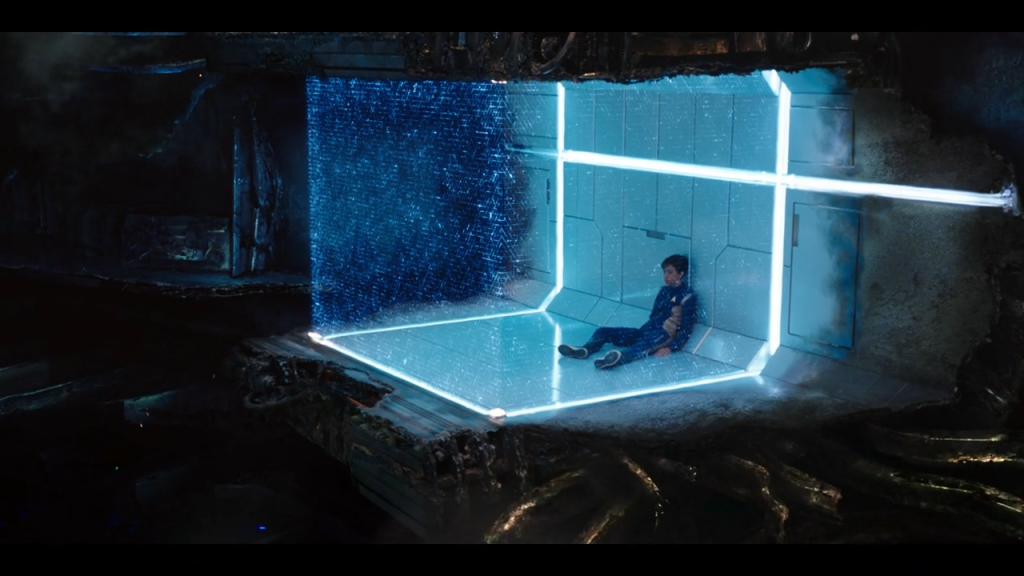
Star Trek Discovery airs on CBS All-Access, their online-only distribution platform for a subscription fee. If you live outside of the US, you can watch it on Netflix weekly. I do not condone nor advocate for the use of alternate means with which to procure and watch this show, you do so at your own risk because WHATEVA-WHATEVA YOU DO WHAT YOU WANT.